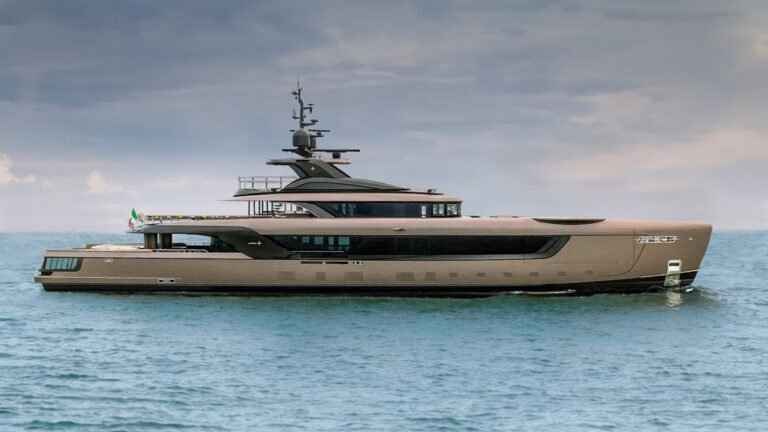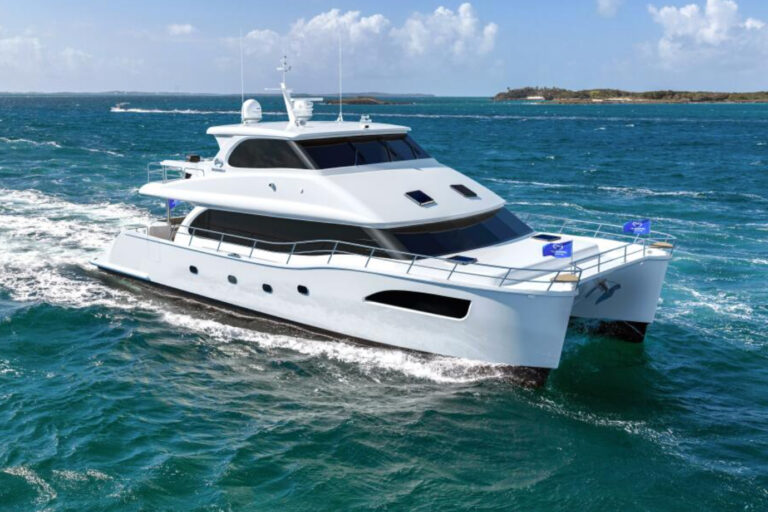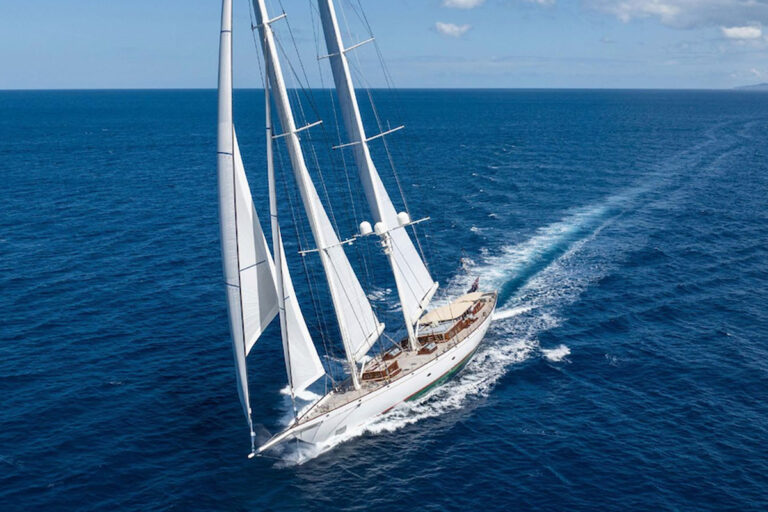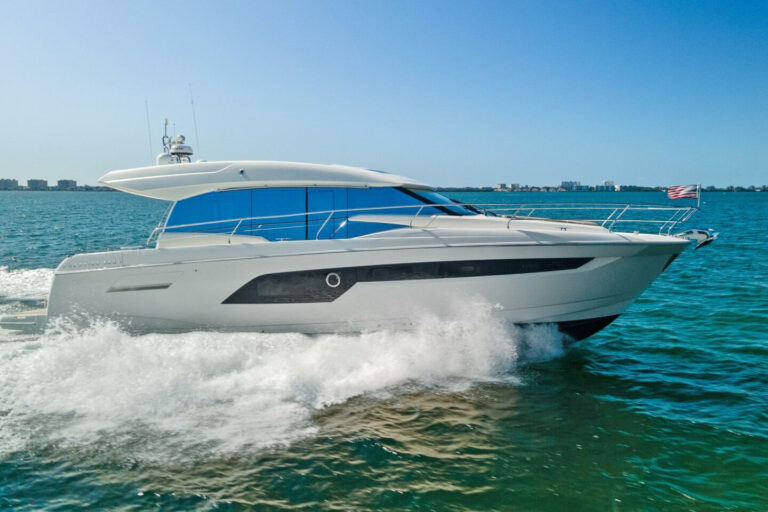Ever since opening shop in the California desert in 1991, Cabo Yachts has been wooing serious anglers. Now Cabo is taking two giant steps. In February, it attracted serious investment when the Brunswick Corporation announced that it had added the Cabo brand to its Hatteras Collection. The other big step, though, was already underway: the Cabo 52, the builder’s largest sportfisher to date.
In the high-end production fish-boat market, the 52 more or less leads the way in terms of size with honorable mention going to Cabo’s popular 45-foot express introduced in 1997. When Cabo’s designer, Michael Peters, put pen to paper, the plan was to capture the imagination of those who might otherwise shop the custom tournament boat market. Peters’ portfolio includes everything from 200-mph unlimited offshore cats to 100-foot motoryachts, and many production builders have tapped his skills as well. I have yet to run one of his hull designs that did not measure up-the 52 is no exception. She is, in my view, the most capable boat that Cabo has put in water to date.
The data I collected during her sea trial off Miami Beach, Fla., is revealing. With a pair of 1,550 hp C32 Caterpillars, the 52 is not shy when the throttles are applied. I measured a maximum speed of 40.8 knots and she reached maximum turns in about 30 seconds without hesitation. Charging along at 37.3 knots (2100 rpm), the Caterpillar electronics indicated a fuel burn of 122 gallons per hour. Cabo offers MAN and MTU packages with similar horsepower and performance as well as 1,360 hp MANs that Cabo suggests will yield a cruising speed of approximately 35 knots. The 1,652 hp C32 Cats are also available and seem an interesting option.
The sea trial data tells only part of the story. The magic of her speed on the water is in the way this boat handles horsepower. When speed/length ratios exceed “4” a hull’s form and balance become critical. It is in this realm that any bad habits a boat might have typically come to light. The 52 handles her horsepower gracefully, and as I twisted her wheel about at speed it was easy to forget that I was commanding a 60,000-pound boat. Seas were relatively mild, yet I am convinced that she will deliver a comfortable ride when others will be forced to reduce throttle. Her convex forward sections are designed to keep head seas in check. Two strakes (per side) control spray forward and, together with a flat chine, keep seawater where it belongs. The outboard strake extends aft adding lift and her 16-degree transom deadrise seems perfect for her length, weight and speed. Modest propeller pockets keep draft to a very manageable 4 feet 6 inches.
One of the advantages of Cabo’s Adelanto, Calif., desert location is that its low humidity is ideal for fiberglass layup. The 52’s hull is a hand-laid blend of stitched multidirectional reinforcements. Vinylester resin is used throughout the laminate and two coats of epoxy are applied to the bottom prior to the application of anti-fouling paint. Core-cell foam is used in the hull sides and bottom-the latter is a first for Cabo. “They asked me what a custom builder would do to add stiffness to the bottom without adding weight and I suggested core,” said Peters, who was responsible for the 52’s weights and balance. “Their attitude was that if the custom guys can do it, we can do it.” Given the above average engineering and execution that I have found to be the standard at Cabo, I would concur. All core materials used on the 52 are vacuum bagged in place to insure a proper bond. A foam-core fiberglass stringer system and plywood bulkheads and web frames provide support. Peters shoots for a longitudinal center of gravity (LCG) that’s 58 percent of the waterline length aft. This can be challenging on a sportfisher as the cockpit essentially dictates engine placement, but the 52’s balance seems perfect.
The engineroom is accessible from the cockpit and even with the 52’s generous allotment of horsepower, there is plenty of room to move about. As is standard practice at Cabo, systems and machinery are installed with clockwork precision. Wiring is so well organized and routed that it is displayed proudly through a viewing port on the engineroom distribution panel. All exposed surfaces here are finished in Awlgrip as are the bronze raw-water plumbing components. Fuel tanks are fiberglass and the tank under the cockpit is fitted with a large tank-top fill with a screw cap. This design allows the use of a high-speed pump or facilitates transferring fuel from a bladder or a drum. The compilation of these features places the 52 far closer to the custom market than most production builders venture.
The 52’s business end will please serious anglers. Her cockpit is clean and uncluttered and the sole is finished with nonskid-though teak would be a nice option. Two large in-sole fish boxes are plumbed with macerators and overboard discharges, and the hatches are guttered, gasketed and have positive latches. A 75-gallon livewell with a viewing port is molded into the transom. The bait-prep center has a sink, tackle storage and an insulated box. Most will likely substitute the latter for the optional refrigeration. A freshwater phone-booth-style shower is located conveniently next to the transom door. Her raised bridge area has L-shaped seating facing a table and three Stidd chairs. The centerline helm looks best with the optional varnished-teak instrument pod, which is dressed with polished-stainless steel panels and side-mount controls. The helm area has room for an electronics mart, and the flush-mount arrangement is fine as long as you remember to cover the electronics before cleanup. A molded cabinet is home to a drawer-style freezer and tackle storage. The final touch: our test boat’s PipeWelders tower.
A sliding door leads below to the open saloon/galley area. L-shaped seating faces a high-low table and the galley has undercounter drawer-style refrigeration. A day head is located conveniently adjacent to the entryway. Storage is excellent and includes a lighted rod locker above the seating area that opens with a push of a button. A hatch in the teak and holly sole allows access to a pump room in the bilge area that is home to air-conditioning and plumbing components. For cruising pack rats there is room to spare.
The master stateroom is forward and is available with a queen island berth or V-berths. The private master head has a stall shower. The guest stateroom has upper and lower berths. Throughout, satin finish teak cabinetwork is crafted with perfection.
The 52 is not for the weak-hearted. She is large for her length, has plenty of power and a premium price that reflects the high standard of her fit, finish and performance. These qualities are not new to Cabo. They are, in fact, the hallmark of the builder’s designs. If you are particularly particular, the 52 Express might be a perfect fit for you.
Contact: Cabo Yachts, (760) 246-8917; www.caboyachts.com









